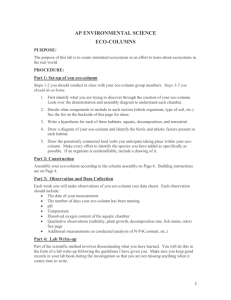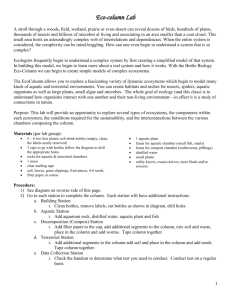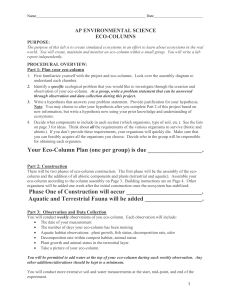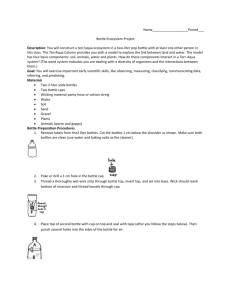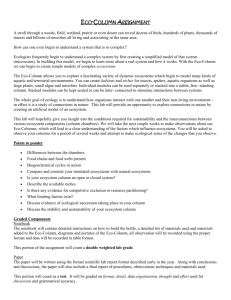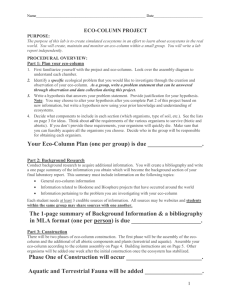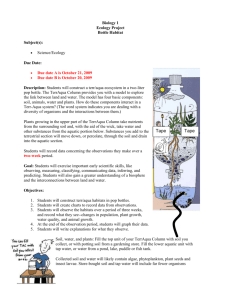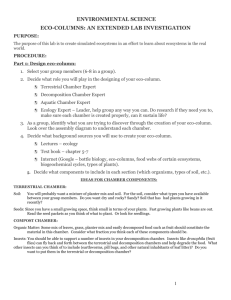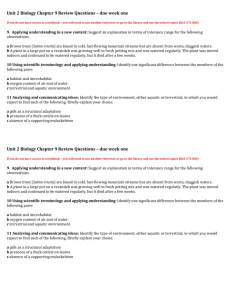EcoColumns
advertisement
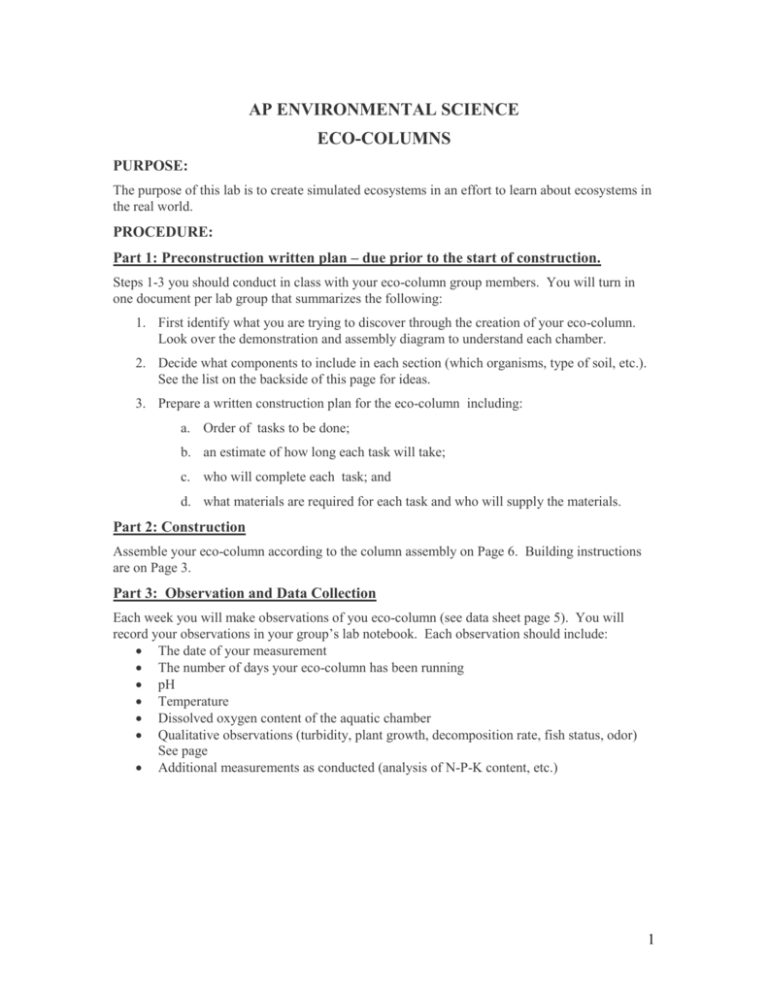
AP ENVIRONMENTAL SCIENCE ECO-COLUMNS PURPOSE: The purpose of this lab is to create simulated ecosystems in an effort to learn about ecosystems in the real world. PROCEDURE: Part 1: Preconstruction written plan – due prior to the start of construction. Steps 1-3 you should conduct in class with your eco-column group members. You will turn in one document per lab group that summarizes the following: 1. First identify what you are trying to discover through the creation of your eco-column. Look over the demonstration and assembly diagram to understand each chamber. 2. Decide what components to include in each section (which organisms, type of soil, etc.). See the list on the backside of this page for ideas. 3. Prepare a written construction plan for the eco-column including: a. Order of tasks to be done; b. an estimate of how long each task will take; c. who will complete each task; and d. what materials are required for each task and who will supply the materials. Part 2: Construction Assemble your eco-column according to the column assembly on Page 6. Building instructions are on Page 3. Part 3: Observation and Data Collection Each week you will make observations of you eco-column (see data sheet page 5). You will record your observations in your group’s lab notebook. Each observation should include: The date of your measurement The number of days your eco-column has been running pH Temperature Dissolved oxygen content of the aquatic chamber Qualitative observations (turbidity, plant growth, decomposition rate, fish status, odor) See page Additional measurements as conducted (analysis of N-P-K content, etc.) 1 Part 4: Lab Write-up Part of the scientific method involves disseminating what you have learned. Make sure you keep good records in your lab book during the investigation so that you are not missing anything when it comes time to write. 2 IDEAS FOR CHAMBER COMPONENTS: AQUATIC HABITAT Fine grained aquarium gravel (provides “bedrock”) Sand or topsoil (provides bottom sediment) Untreated tap water or distilled water (provides aquatic habitat) “Boulders,” “sunken logs,” and other miniature objects typical of a pond bottom Aquatic plants and animals COMPOST HABITAT Fine grained aquarium gravel (provides “bedrock”) Sand/topsoil mix (provides soil substrate) Leaf litter (provides compost habitat) A few chunks of turnips, potato, apple, or other roots, stems, or fruits Twigs Earthworms, pill bugs, millipedes, and other natural inhabitants of leaf litter TERRESTRIAL HABITAT Fine-grained aquarium gravel (provides “bedrock”) Topsoil (provides soil substrate) Leaf litter (provides decaying material) “Boulders,” “dead trees,” and other miniature objects typical of a forest habitat Terrestrial plants and animals Food for animals as needed 3 BUILDING INSTRUCTIONS 1. Follow the instructions for making cuts in Column Assembly 2. Melt or drill a hole in three of the bottle caps and screw onto the cap for F, D, C. Note cap for D also has large hole in center. 3. Insert the straw through the hole in the bottle cap of what will be the Terrestrial habitat (bottle D). Straw should extend below cap and above soil. 4. Invert Bottle D (terrestrial habitat) over Bottle C and invert both over Bottle B (aquatic habitat). STOCKING INSTRUCTIONS Aquatic habitat (Bottle A) 5. Add a layer of sand or topsoil (about 1 inch) to the deep base. 6. Add a layer of gravel (about 1 inch) on top of the sand or topsoil. 7. Add water to a level about 1 inch below the top of the cut. 8. Plant aquatic plants with roots in the bottom sediment. A chopstick will help you push the stems or roots into the ground. 9. Arrange “boulders” and other objects on the bottom sediment. 10. Add floating aquatic plants (duckweed). 11. Let the aquarium sit until the sediment settles. 12. Add aquatic animals. Compost habitat (Bottle C) 13. Mix equal parts of sand and topsoil together and add leaf litter. 14. Mix food items in. 15. Add compost animals as needed (you may collect some with the leaf litter). Terrestrial habitat (Bottle D) 16. Add a layer (¾ inch) of gravel to the Bottle D 17. Mix soil and potting soil together, moisten, and add a layer (3-4 inches) over the gravel. 18. Add terrestrial animals that burrow to the soil (e.g., worms). 19. Plant terrestrial plants in the soil. 4 20. Arrange “dead trees” and other objects on soil. 21. Add the remaining terrestrial animals. Maintenance Instructions 22. Provide a light source, preferably indirect window light. A small desk lamp or plant light will work, too. For artificial lights, provide 12 – 14 hours of light daily. 23. Add a small amount of water to the terrestrial habitat weekly or when it appears to be drying out. A fine spray of water on the plants also maintains the unit well. ECO-COLUMN DATA COLLECTION SCALES Aquatic Fauna Turbidity Scale Live Dead Crystal Clear = 1 Slightly Cloudy = 2 Moderately Cloudy = 3 Very Cloudy = 4 Blackish or Brownish = 5 Odor Scale No odor =1 (for Aquatic Habitat) Slight odor = 2 Smelly = 3 Very Smelly = 4 Devastating = 5 5 ECO-COLUMN DATA COLLECTION DATE: _______________ DO______ PERIOD: _________ TEAM: __________ TEMP (C) ___________ pH_________ TURBIDITY__________ NITROGEN________ PHOSPHATE ____________ ODOR _______________ TERRESTRIAL FAUNA _________________________________________________ ______________________________________________________________________ TERRESTRIAL FLORA_________________________________________________ ______________________________________________________________________ DECOMPOSITION______________________________________________________ ______________________________________________________________________ AQUATIC FAUNA______________________________________________________ ______________________________________________________________________ AQUATIC FLORA______________________________________________________ ______________________________________________________________________ MICROORGANISMS____________________________________________________ _______________________________________________________________________ _______________________________________________________________________ OTHER SIGNIFICANT OBSERVATIONS ___________________________________ _______________________________________________________________________ _______________________________________________________________________ _______________________________________________________________________ _______________________________________________________________________ 6
